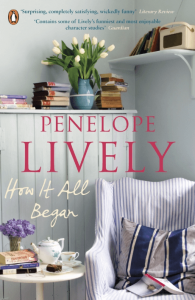
What I learned from… ‘How it all began’ by Penelope Lively
 About the book
About the book
The novel begins with an elderly woman named Charlotte Rainsford being mugged and injured on a London street. This event has a ripple effect on the lives of various people connected to her. Her daughter Rose, who takes time off from work to care for her, finds her own life disrupted. Her employer, a married academic named Henry, is forced to rethink his priorities when Rose’s absence affects his work and marriage. Marion, Henry’s wife, becomes introspective about her own life choices.
As the novel progresses, it delves into the personal histories, choices, and relationships of these characters, exploring themes of chance, fate, and the unpredictability of life.
What I learned
I’ve read several Penelope Lively novels before – Heat Wave being one of my favourites. She’s a master at conjuring an atmosphere, creating compelling characters and packing a huge amount of story and emotions in (usually) slim books.
How It All Began uses the mugging of central character Charlotte as a plot device that changes the lives of several characters. The omniscient narration follows everyone around Charlotte as the fallout of the attack changes all of them for good or ill.
As ever, reading a Lively novel is effortless; the prose light and funny, and the characters realistic and flawed, especially the pompous, self-obsessed bore Henry Peters who deserves his own spin-off. She moves so well from one character to another that you barely notice it happening:
‘An hour,’ said Delia Canning. ‘A single feature. Docudrama, maybe. I can promise nothing. We’ll have to think!’
‘No, no,’ said Henry. ‘Six parts, I envisage. A series.’
They were in her office, where supplicants were normally at a disadvantage. He was not, it seemed. His loud, plummy tones filled the room. His capacious form filled her office chair; she hadn’t seen a tweed suit like that in decades. Her grandfather had had one, for church on Sundays.
She shook her head. ‘Out of the question, I’m afraid.’
Small, sharp-featured woman. Trousers and a shirt; one would have thought something more formal for a person in a top job here, or so he understood. He felt wrong-footed, having to negotiate like this with a young woman. She hadn’t yet got the hang of what he had in mind. He elaborated: ‘…the essence of the Augustan age – the politics, the art, the architecture – one would look at science and industry, of course, plenty of visual opportunity there, your people would be able to work out the…locations…Ironbridge, that sort of thing…wouldn’t be averse to the occasional period costume – I gather it’s expected these days – but not too much. Enlightenment would be the idea, enlighten and inform the viewer, enlightenment the appropriate word for the eighteenth century, don’t you agree?’
Unbelievable. You didn’t come across people like this today, at least she didn’t. She eyed him. A certain awful appeal, there was no getting away from it.
Lively expertly weaves all her storylines from the mugging in surprising ways. Usually in omniscient novels with several different storylines, I enjoy reading one more than the other, but Lively doesn’t linger too long with one particular character, meaning the whole she creates is much more than just the sum of its parts.
More about this book
Published in 2012 by Penguin
About ‘What I learned…’
 About the book
About the book